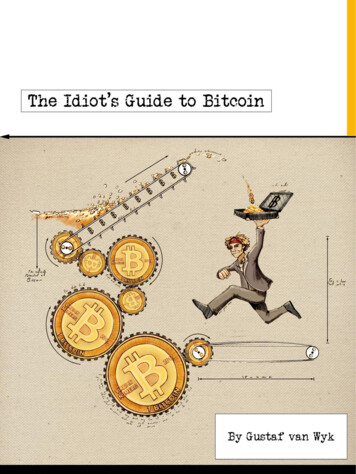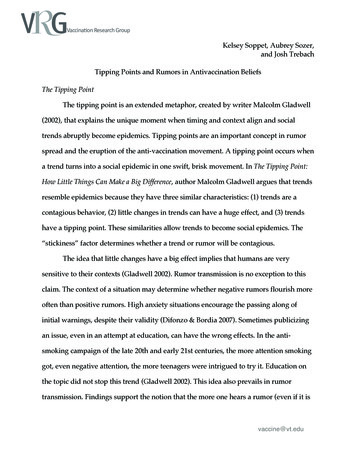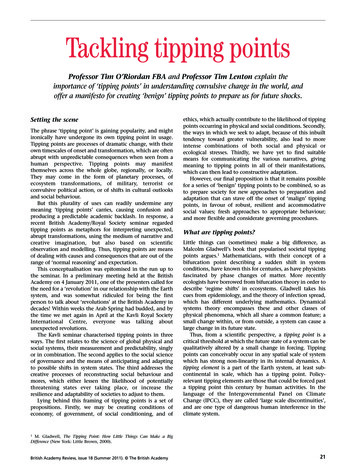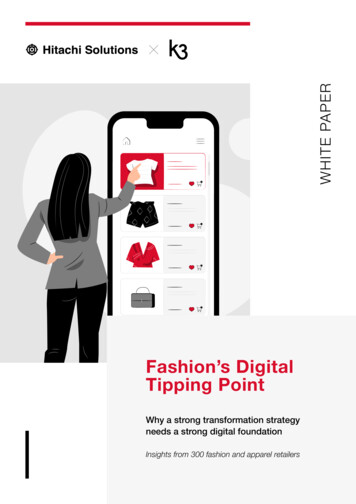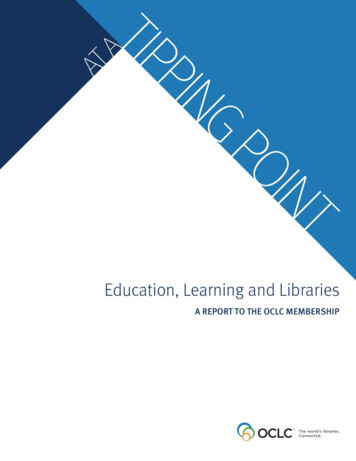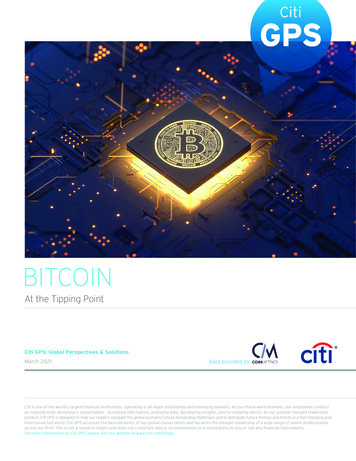
Transcription
BITCOINAt the Tipping PointCiti GPS: Global Perspectives & SolutionsMarch 2021Data provided byCiti is one of the world’s largest financial institutions, operating in all major established and emerging markets. Across these world markets, our employees conductan ongoing multi-disciplinary conversation – accessing information, analyzing data, developing insights, and formulating advice. As our premier thought leadershipproduct, Citi GPS is designed to help our readers navigate the global economy’s most demanding challenges and to anticipate future themes and trends in a fast-changing andinterconnected world. Citi GPS accesses the best elements of our global conversation and harvests the thought leadership of a wide range of senior professionalsacross our firm. This is not a research report and does not constitute advice on investments or a solicitations to buy or sell any financial instruments.For more information on Citi GPS, please visit our website at www.citi.com/citigps.
Citi GPS: Global Perspectives & SolutionsSandy KaulGlobal Head of Citi Business AdvisoryServicesMarch 2021Richard WebleyHead of Citi Global Data Insights 1-212-723-4576 richard.webley@citi.com 1-212-723-5118 sandy.kaul@citi.comJonathan KleinAssociate, Citi Business Advisory ServicesShobhit MainiMarkets & Securities Services Transformation 1-212-723-2622 jonathan.klein@citi.com 44-20-7508-7470 shobhit.maini@citi.comOmid MalekanBlockchain Innovation ExpertCiti VenturesAdjunct Professor, Columbia BusinessSchoolIoana NiculceaFinTech & Emerging Technology Lead,Citi Business Advisory Servicesomid.malekan@citi.com 1-212-723-5075 ioana.niculcea@citi.com
March 2021Citi GPS: Global Perspectives & SolutionsBITCOINAt the Tipping PointKathleen Boyle, CFAManaging Editor, Citi GPSThe first Citi GPS venture into digital currency was back in 2014 when we featured itin an article in our second Disruptive Innovations report. Although we discussedBitcoin, we did so with the caveat that it was a branded digital currency and a freelyavailable generic Bitcoin technology but there was the potential that a non-Bitcoinalternative digital currency would one day supplant it. In May 2014, when wepublished the report, Bitcoin was just five years old with a market value around 6.2billion. We wrote that Bitcoin was familiar and welcome to younger generations andalthough older investors may have heard the word, they were generally less familiarwith it and more skeptical. We recognized there was very little Bitcoin activityamong institutional investors in organized financial markets as it was considered 'fartoo risky and volatile'. In the end, we still assessed Bitcoin as a 'wannabe asset' anda 'wannabe means of transaction' and lamented that although you could have a lotof Bitcoin, but there wasn't much to do with it.Another thing we've learned while writing Citi GPS reports on disruptive innovationsis the time it takes a new product to become widely used by global customers hasdecreased dramatically. According to Visual Capitalist, it took the telephone 50years to reach 50 million customers, 22 years for television, seven years for theInternet and just 19 days for Pokémon Go. So it's not a surprise the uptake ofBitcoin in the past almost 7 years has been nothing but extraordinary. Not only hasBitcoin increased in usage and value (hitting 1 trillion in market capitalization inFebruary 2021), but it has created a whole ecosystem around it — including cryptoexchanges, crypto banks, and new offerings into savings, lending, and borrowing.In the report that follows, the authors note the biggest change with Bitcoin is theshift from it being primarily a retail-focused endeavor to something that looksattractive for institutional investors. In a search for yield and alternative assets,investors are drawn to Bitcoin's inflation hedging properties and it is recognized as asource of 'digital gold' due to its finite supply. Specific enhancements to exchanges,trading, data, and custody services are increasing and being revamped toaccommodate the requirements of institutional investors.Bitcoin is also evolving as the 'North Star' in the digital asset space and is acompass for the evolution of a broader ecosystem of crypto commerce. Newinnovations, including the announcement of fiat-backed stablecoins, used withinpublic and private networks, may build pressure for central banks to consider theirown digital currency options.Where could Bitcoin be in another seven or so years? The report notes theadvantage of Bitcoin in global payments, including its decentralized design, lack offoreign exchange exposure, fast (and potentially cheaper) money movements,secure payment channels, and traceability. These attributes combined with Bitcoin'sglobal reach and neutrality could spur it to become the currency of choice forinternational trade.There are a host of risks and obstacles that stand in the way of Bitcoin progress.But weighing these potential hurdles against the opportunities leads to theconclusion that Bitcoin is at a tipping point and we could be at the start of massivetransformation of cryptocurrency into the mainstream. 2021 Citigroup3
MAINSTREAM ACCEPTANCEOR SPECULATIVE IMPLOSION?BITCOIN SHOWING GROWING LEVELS OF ADOPTIONINSTITUTIONAL INTEREST IN BITCOIN ACCELERATESBitcoin initially drew interest from owners for its underlyingtechnology and social value proposition plus its financialpotential. As it has matured, attention has shifted to thebusiness case around Bitcoin, its expanding utilization, andthe growing commerce ecosystem around cryptocurrencies.The intersection of low yields and inflationary expectationshas increasingly fostered the institutional investor viewthat Bitcoin could represent an inflation hedge, a portfoliodiversifier, and a safe haven not currently offered bytraditional government bonds all at once.Indications of increased institutional activity in Bitcoin include:Open interest in CMEs Bitcoin futures, a benchmark forinstitutional activity, surged by over 250% between October2020 and January 2021.36% 536 million. 55%of small-medium businessin the U.S. acceptingBitcoin in 2020Bitcoin monthly tradingvolumes in South Africa andNigeria in August 2020Source: HSBSource: ReutersThe holding period for Bitcoin has increased, with 10% of Bitcoinnow being held for five years or longerSource: Coin MetricsPercent of Bitcoin Supply Held Over Time60%50%40%30%20%10% 20 billion per day 500 billionBitcoin OTC tradingvolumes in early 2020Crypto exchange volumes inthe first three weeks of 2021,twice the volumes of 2017-2018Source: Hacker 6/1912/1906/2012/200%1 Years2 Years3 Years4 Years5 YearsSource: CoindeskOwnership of Bitcoin is primarily retail, but institutions areincreasingly interestedSource: Blandin et al 8%82%1,5009%20%LatAmThe number of blockchain addresses holding 1,000 Bitcoinshas increased steadilySource: Coin Metrics16%MENA1,000APAC75%75%500Retail 2021 CitigroupBusiness and Institutional 1812/1806/1912/1906/2012/200
MAPPING THE FUTURE FOR BITCOINPerceptions about what makes Bitcoin important continue to evolve and create new opportunities whileincreasing its perception towards becoming mainstream. A focus on global reach and neutrality could seeBitcoin become an international trade currency. This would take advantage of Bitcoin’s decentralized andborderless design, its lack of foreign exchange exposure, its speed and cost advantage in moving money, thesecurity of its payments, and its traceability.Focus on CensorshipResistance/Store of ValueMainstreamFocus onTechnologyFocus onScarcityGlobal TradeFacilitator?CurrencyPerceptionInnovativeFocus on Globality/Value Exchange NetworksDigital Gold“North Star” ofBlockchain Eco-SystemNew Type of PaymentSystem/BlockchainPart of Dynamic On-ChainCommerce MarketplaceTimeOBSTACLES REMAINThe entrance of institutional investors has sparked confidence in cryptocurrency but there are still persistent issues that could limit widespreadadoption. For institutional investors, these include concerns over capital efficiency, insurance and custody, security, and ESG considerationsfrom Bitcoin mining. Security issues with cryptocurrency do occur, but when compared to traditional payments, it performs better.Illicit ActivityTotal Illicit ValueSource: Chainalysis and U.S. Federal Reserve 720182019 200.34%2.13%As a % of total cryptocurrencytransfer value (2020)As a % of total cryptocurrencytransfer value (2019) 15 10 513.46bp4.38bpFraud rate, by value, inaggregate credit & debitcards (2016)Aggregate fraud rate, bynumber, in depositoryinstitutions (2015) 0Total Illicit Value —USD Billions 0101011101100100011011012020Share of Total CryptocurrencyTransfer Value (RHS)1.0%0.5%0.0%
6Citi GPS: Global Perspectives & SolutionsMarch 2021ContentsIntroductionAcknowledgementSection 112Section II24Bitcoin Origins: Launch of a New Payment SystemOriginal Goals of the NetworkA New Kind of Payment System; A Different Kind of CurrencyFirst Decade Marked by Speculation & PushbackMaturation of Ecosystem Spurs Fresh ConsolidationBitcoin as a Payment Option Moves Toward the MainstreamBitcoin Exchanges Expand Options as Bank-Like Services for Retail EmergeViews that Bitcoin Represents 'Digital Gold' Gain TractionInstitutionalization of the Ecosystem Begins to Re-Shape LandscapeMaturation of the Market Structure to Support Institutional InvestorsRegulatory Announcements Start to Provide More Certainty to EstablishedFirmsSection IIIInvestors Bet on Bitcoin's Potential as Digital Gold & the North Star of theCrypto DomainMarket Liquidity & Depth Shows Growing Level of AdoptionMacro Trading Environment Drives Institutional View of Bitcoin as SafeHaven and Inflation HedgeInstitutional Interest in Bitcoin AcceleratesBitcoin’s Success Drives Spillover Benefits for Broader Crypto EcosystemBitcoin as the 'North Star' of the Digital Asset SpaceSection IVMapping the Future: Bitcoin May Benefit from Broadening Use of BlockchainTechnologiesMoving from Traditional Payment Rails to Payment NetworksFiat Currency Stablecoins Create More Interoperability between EcosystemsCryptocurrency and Asset-Backed Stablecoins Offer New Use CasesStablecoin Template Sets Stage for Introduction of Private NetworksGovernments Contemplate the Creation of Central Bank Digital CurrenciesGlobal Accessibility of Bitcoin May Spur Future Transition to Trade FacilitatorSection VObstacles Remain that Could Slow or Reverse Bitcoin’s ProgressInstitutional Adoption Can Only Go So Far in the Current EnvironmentSecurity Concerns:Increased Regulatory Certainty May Trigger Crypto Native Backlash, DivideLiquidityOther Cryptocurrencies May Overtake and Displace BitcoinMacro Environment May Shift and Siphon-off Institutional InterestConclusion 2021 73737480818284909191939899100102
March 2021Citi GPS: Global Perspectives & SolutionsIntroductionFor an innovative asset just over a decade old, Bitcoin has already amassed a fairlystoried history. There is the mystery of its founder, the anti-establishment creed ofthe cypherpunk movement that spawned it, lingering suspicions that it is used inillicit activities, the multi-million dollar pizza transaction, and its notorious volatilitywith not just one, but three distinct speculative bull runs, two of which resulted inequally dramatic collapses and the third of which is currently underway.1Large swaths of the traditional banking and financial markets view Bitcoin as acompletely valueless asset. Nouriel Roubini, a professor at New York University’sStern School of Business, recently called it a “self-fulfilling bubble” and claimed thatthe stone age cartoon family, the “Flintstones had a better monetary system.”And yet The novelty of the blockchain technology underpinning the Bitcoin payment systemnetwork has been hailed as a breakthrough and a growing ecosystem ofapplications and use cases are emerging to validate its importance and utility. The use of Bitcoin as a censorship-resistant store of value is facilitating itsexpanding use as a currency: PayPal, Visa and Mastercard are now accepting itacross their vast merchant networks; brand name companies such asMicrostrategy and Tesla are moving parts of their corporate treasuries intoBitcoin; charities like the American Cancer Society are accepting Bitcoindonations; there were nearly 12,000 Bitcoin ATMs deployed by the end of 2020;a new Visa credit card allows users to earn Bitcoin as rewards; and morecompanies are beginning to accept Bitcoin payments, including one that lets youpay for your next space voyage in Bitcoin. Bitcoin’s engineered approach to ensuring digital scarcity is also prompting manyexperienced investors to compare it to digital gold. Source code in the Bitcoinnetwork only allows for the creation of 21 million Bitcoins, of which 18.6 millionare already in circulation. The complexity of mining Bitcoin becomes increasinglydifficult as more supply emerges based on its algorithmically-designed approachthat adjusts down the rate of production as more coins enter circulation, whichhelps to insulate it from inflation. Given today’s macro investing environment,many investors are looking to hold Bitcoin positions as a hedge given fiscal andmonetary Covid-19-related policy impacts.These evolving views of Bitcoin are being facilitated by an ecosystem that isbecoming increasingly professionalized. Bitcoin holders can earn interest on theirbalances, loan their coins, and even borrow against them. Cryptocurrencyexchanges that were vulnerable to technology disruptions and liquidity concerns inthe 2017 rally have become far more secure, can stream their prices via applicationprogramming interfaces (APIs), have introduced a broad set of risk and analytictools, and offer specialized algorithms to improve execution. Over-the-counter(OTC) trading desks are facilitating larger order sizes and derivatives are gainingopen interest.1“Dr. Doom Economist Nouriel Roubini says ‘The Flintstones had a Better MonetarySystem than Bitcoin’ and the Token Should Not Be Considered a Currency,” Will Daniel,February 17, 2021, Business Insider. 2021 Citigroup7
8Citi GPS: Global Perspectives & SolutionsPrime brokerage offerings are providing best execution services and marginfinancing, while third-party custody solutions are creating viable options forsafekeeping and are obtaining insurance to protect against loss and theft of assets.Regulators are starting to offer guidance, and in some jurisdictions, register andlicense cryptocurrency participants.Moreover, while many in the traditional world view Bitcoin as revolutionary, there isa growing set of businesses emerging on blockchain-based platforms looking tocreate innovations that far surpass Bitcoin’s original goals. Decentralizedapplications (DApps) are being created and are experimenting with new approachesto governance, asset creation, peer-to-peer transactions, and algorithmicallydesigned servicing. The decentralized finance (DeFi) space is surging, with totalvalue locked in these DApps increasing 20x — from 1.0 billion in January 2020 to 10.0 billion by year-end.2 To these businesses, Bitcoin is the 'North Star' that pointsthe way and its success is seen as a barometer of interest in the overall on-chainecosystem.Moving money between the traditional fiat currency-based economy and thisemerging on-chain landscape has been difficult, relying on traditional payment railsand networks that often place limits on the extent of user activity. Stablecoins are anewer offering providing a more efficient mechanism that acts as on and off rampsbetween the two domains.Fiat currency stablecoins are collateralized vehicles that can be used to move largesums of money from the off-chain into the on-chain ecosystem and allow thosecoins to circulate like any other cryptocurrency within blockchain-based ledgers anddigital wallets. These coins are effective for use within public network blockchains,but they also provide a template for private networks.Diem, formerly the Facebook Libra initiative, is creating a private stablecoin for usewithin their members-only network comprised of brand name firms such as Uber,Lyft, Spotify, and Facebook. Other private networks are also emerging. Thesedevelopments increase the potential of a growing share of daily transaction activitybeginning to occur in private coins that lie outside government control. As such,pressure is growing for governments to issue their own digital currencies. A January2021 study of 60 central banks by the Bank of International Settlements found that86% indicated they were engaged in some work on Central Bank Digital Currencies(CBDCs) and 60% were either running experiments or proofs of concept.3If these efforts progress to the actual issuance of central bank-backed digitalcurrency, blockchain would become a mainstream offering. Individuals andbusinesses would have digital wallets holding a variety of cryptocurrencies,stablecoins, and CBDCs just like they today have checking, savings, and treasuryaccounts. Connectivity between the traditional fiat currency economy, publiccryptocurrency networks, and private stablecoin communities would become fullyenabled.2"What’s in store for DeFi in 2021? The Analysis and Predictions", BTC Peers, January18, 2021, Yahoo Finance3 Ready, Steady, Go? Results of the Third BIS Survey on Central Bank Digital Currency,BIS Papers No. 114. 2021 Citigroup
March 2021Citi GPS: Global Perspectives & SolutionsIn this scenario, Bitcoin may be optimally positioned to become the preferredcurrency for global trade. It is immune from both fiscal and monetary policy, avoidsthe need for cross-border foreign exchange (FX) transactions, enables nearinstantaneous payments, and eliminates concerns about defaults or cancellationsas the coins must be in the payer’s wallet before the transaction is initiated.Obstacles and challenges still exist and while the path we describe for Bitcoin ispossible, it is by no means assured. Upgrades in the way the marketplace workswould be required before broad institutional participation could be envisioned. Suchenhancements would move Bitcoin and the cryptocurrency space closer to theoversight and rules of traditional financial regulators. This in turn may cause manyof the most innovative developers and entrepreneurs to exit the ecosystem, as itmoves away from the anti-establishment ethos of Bitcoin’s roots. Finally, the macroinvesting environment may shift and make the need for a new asset with Bitcoin’sprofile less pressing.Bitcoin’s future is thus still uncertain, but developments in the near term are likely toprove decisive as the currency balances at the tipping point of mainstreamacceptance or a speculative implosion. 2021 Citigroup9
10Citi GPS: Global Perspectives & SolutionsAcknowledgementIn preparing to write this report, we completed a series interviews with CEO's and professionals of some of the leadingcustodians, prime brokers, exchanges, infrastructure, and asset management companies, in addition to select experts withinCiti. We thank them for all of their sharing their knowledge and expertise.Nick CarmiZac PrinceJonathan LevinMorgan McKenneyTony McLaughlinPuneet SinghviItay TuchmanTim RiceItay MalingerBin RenJames SticklandThomas ChippasCEO, BitGo PrimeCo-Founder & Chief Strategy OfficerEmerging Payments & Business Development,Treasury & Trade SolutionsGlobal Head of FX, MSSCo-Founder & CEOCEOJuri BulovicDirector, Bitcoin Mining 2021 CitigroupFounder & CEOCOO of Global Consumer BankHead of DLT and Digital Assets, MSSCo-Founder & CEOBoard MemberCEO
March 2021Citi GPS: Global Perspectives & SolutionsMichael ShaulovDave BalterRochelle GuillouEric StoneMichael MoroMichael SonnensheinRune ChristensenMatt LongWayne TrenchCristián BohnMarcos ViriatoMatteo LeibowitzCo-Founder & CEOMarket AnalystCEOCEOCEOCo-Founder & CEO 2021 CitigroupCEOHead of Data ScienceCEOHead of Distribution & PrimeCo-Founder, CFO & CPOStrategy Lead11
12Citi GPS: Global Perspectives & SolutionsSection 1 2021 Citigroup
March 2021Citi GPS: Global Perspectives & SolutionsBitcoin Origins: Launch of a New PaymentSystemIn August 2008, the domain name bitcoin.org was registered online. Two monthslater, a paper entitled “Bitcoin: A Peer-to-Peer Electronic Cash System” emergedfrom an author named Satoshi Nakamoto.4 For a document that launched afinancial revolution, the Bitcoin white paper is surprisingly sparse.5 It is only ninepages long and focused primarily on the technical specifications of the proposednetwork: a distributed transaction record made immutable with cryptography,pseudonymous access enabled by cryptographic keys, and a transactionverification process known as proof of work. The words blockchain, cryptocurrency,and mining do not appear in it.We still do not know the identity of the individual or group who wrote that paper andsubsequently helped to design and establish the network, despite the fame andriches that could come from launching a trillion-dollar industry.6 We can onlyspeculate about their motivation, but their early writings reveal something far lessambitious than what Bitcoin has turned out to be.Original Goals of the NetworkDespite the popular belief within crypto circles that Satoshi Nakamoto was somekind of a monetary prophet out to dethrone fiat currency, a closer read reveals themto be more of a technical expert trying to design a new type of payment system. Theword currency only appears once in the white paper, and only in reference tophysical cash. Looking at Figure 1 you can see what Satoshi’s intentions were inthe original whitepaper.Figure 1. Satoshi Nakamoto's WhitepaperSource: Satoshi Nakamoto Institute4“Everything You Need to Know About Bitcoin”, Zoe Bernard, Business Insider,November 10, 2018.5 “Bitcoin: A Peer-to-Peer Electronic Cash System”, Satoshi Nakamoto, Bitcoin.org,October 31, 2008.6 Total crypto market capitalization data from Coin Metrics. 2021 Citigroup13
14Citi GPS: Global Perspectives & SolutionsNakamoto published the paper in a mailing list dedicated to the cypherpunkmovement — a loosely affiliated group of individuals who believed that cryptographyshould be used to preserve sovereignty and privacy on the Internet.7 He was not thefirst person to attempt to invent a peer-to-peer payment solution, and most of thetechnical components of his creation were invented by others (as cited in thepaper). But he succeeded where others had failed because of his novel solution tothe problem of digital scarcity.This concept of digital scarcity is critical. At its core, digital scarcity means beingable to control both the amount of a certain good and how it is exchanged in theonline world.8 A new type of payment network might be devised to control howmoney is exchanged, but how do you control the amount of money that movesthrough that network to ensure it is not being copied and double-spent?Money, as we understood it before Bitcoin, existed in two forms: either as a physicalobject that’s hard to produce and replicate (e.g., gold coin or dollar bill) or a ledgerentry preserved by an authority, like a corporation or government.Electronic payments had already been around for over 130 years, arguably datingback to when Western Union launched a telegram-based payment service.9 But thatpayment system, along with every other one invented since, required a powerfulintermediary who played the role of a trust bearer to update the ledger and preservethe integrity of the money contained in it. Venmo users can only send the samedollar once, for the simple reason that Venmo will not let them double-spend thatmoney, and might kick out those who try.Bitcoin sought to build an electronic payment system operating without such anintermediary, but one that would still preserve integrity by preventing doublespending. Before Bitcoin, similar attempts at building decentralized payments hadstumbled on the issue of digital scarcity: if nobody is in charge, how do you preventusers from cheating?Nakamoto’s main contribution was the use of financial rewards to incentivize honestbehavior. Unlike a traditional payment system, where a known, central entityvalidates all transactions, Bitcoin incents pseudonymous users to validatetransactions. One fundamentally important fact is that Bitcoin pays user in the nativecurrency of the network. Paying that reward is the final step in a complicated chainof events unfolding every ten minutes, on average.The potential of a distributed system where different nodes come to a consensus onthe likeliest version of reality dates back to the space program, and wasmathematically solved 40 years ago.10 If the Bitcoin network was operated by agroup of known governments or corporations, they could just vote on whichtransactions were valid. There would be no need for all of the cryptographiccomplexity and electricity usage.7“Cypherpunk”, Wikipedia.“What is Digital Scarcity? How is it Useful?”, Nikhill Rajesh, Simple Snippets, July 12,2018.9 “6 fascinating things about Western Union’s history”, Cecilia Hendrix, Western Union,October 8, 2019.10 “The Byzantine Generals Problem”, Leslie Lamport, Robert Shostak, and MarshallPease, SRI International, July 1982.8 2021 Citigroup
March 2021Citi GPS: Global Perspectives & SolutionsBut Nakamoto was more ambitious and wanted to let anyone participate inconsensus, and to do so anonymously. Voting was no longer an option because oneparticipant could now pretend to be many and stuff the ballot, like an unscientificonline poll where anyone can vote as often as they like. To maintain integrity, theBitcoin protocol asks for volunteers known as miners to vet transactions oneveryone else’s behalf. Those who would like to try, have to prove honest intent byspending resources.Every Bitcoin transaction is sent to a transparent queue to await approval. Would-beminers process the latest transactions — looking at the ledger data to make sure (1)the money being sent is actually there, (2) it is being sent by the rightful owner, and(3) it is not being double-spent. The would-be miner then packages the transactionsthey have reviewed into a cryptographically-secured data package known as ablock. Each block is mathematically linked to the most recent one, forming a chain.But before broadcasting the latest block to everyone else, miners have to solve acryptographic problem, one that forces them to use a lot of electricity. Bitcoin miningis highly competitive. The miner who solves the problem first gets to share theirfindings with the rest of the network, where it’s double checked by everyone else. Ifthe work was honest, that winning miner gets paid a combination of transaction feesand newly minted coins.11Miners have a vested interest keeping Bitcoin valuable as they spend their localcurrency (USD, RMB, etc.) to compete but earn Bitcoins as their reward. The bestway to do that is by not cheating the system. There are many ways to successfullyattack this process. It just so happens that doing an honest job is more profitable.Digital scarcity has therefore been secured in two ways. Miners are motivated toprevent double spending, and paid via algorithmically-controlled rewards. In itssource code, Bitcoin stipulates there will only ever be 21 million coins created. Thevast majority have already been minted.12The amount of new Bitcoin released with each mined block is called the “blockreward”. The size of this reward is halved every time 210,000 blocks are added tothe blockchain, approximately every 4 years. In Bitcoin’s early days, the winningminer would receive 50 Bitcoins. In 2012 the figure was halved to 25 Bitcoins andwas again cut in 2016 to 12.5 Bitcoins. In May 2020, the block reward was cut to6.25 Bitcoins.13 This approach not only helps to protect the value of Bitcoin frominflationary pressures, but it also reinforces the concept of digital scarcity.Sending a Bitcoin transaction also requires payment of a transaction feedenominated in its native asset to the miners. Expectations are that when the full 21million Bitcoin are in circulation, the transaction fee alone should become incentiveenough to sustain the system because the volume of transactions should besignificant, and the price of the coin high.1411“Mastering Bitcoin”, Andreas M. Antonopoulos, O’Reilly Media, June 8, 2017.“What Happens to Bitcoin After All 21 Million are Mined?”, Adam Hayes, Investopedia,December 17, 2020.13 Ibid.14 Ibid.12 2021 Citigroup15
16Citi GPS: Global Perspectives & SolutionsThe technical and monetary nature of Bitcoin’s design mean the network could notsurvive without the native asset, and vice versa. Today, most people think ofblockchain as a decentralized network technology enabling a new kind of currency.While true, it’s also possible to assert that the currency was actually invented toenable the network.I think Bitcoin is the next stop on the evolution of money andvalue. Society dictates what money is and we've evolvedfrom rocks,
Associate, Citi Business Advisory Services 1 -212-723-2622 jonathan.klein@citi.com . Shobhit Maini . Markets & Securities Services Transformation 44 -20-7508-7470 shobhit.maini@citi.com . Omid Malekan . Blockchain Innovation Expert Citi Ventures Adjunct Professor, Columbia Business School . omid.malekan@citi.com . Ioana Niculcea





